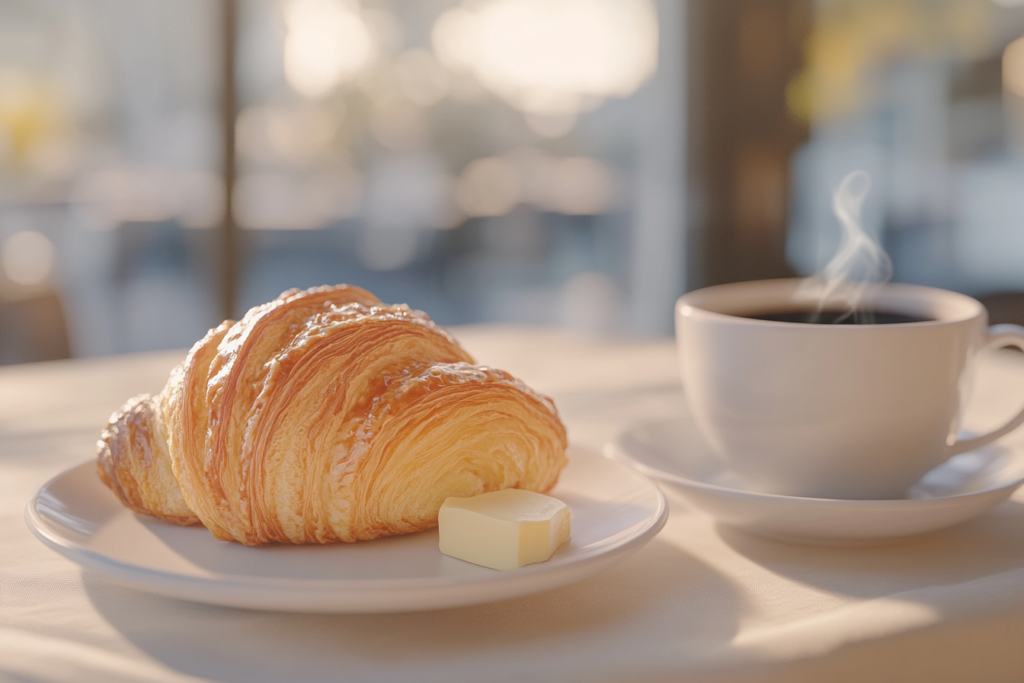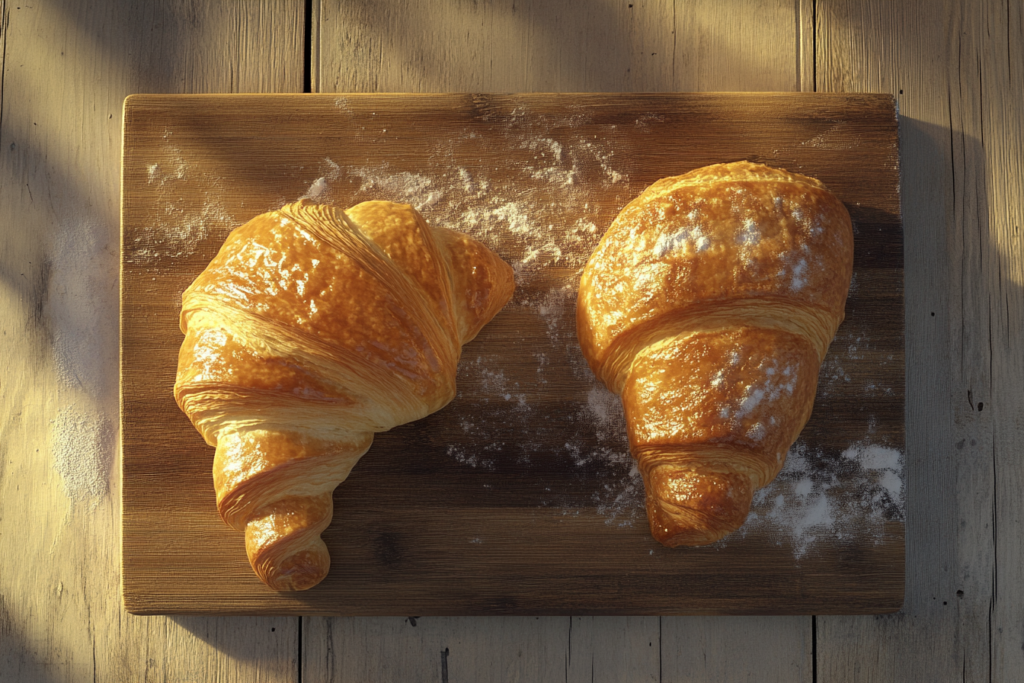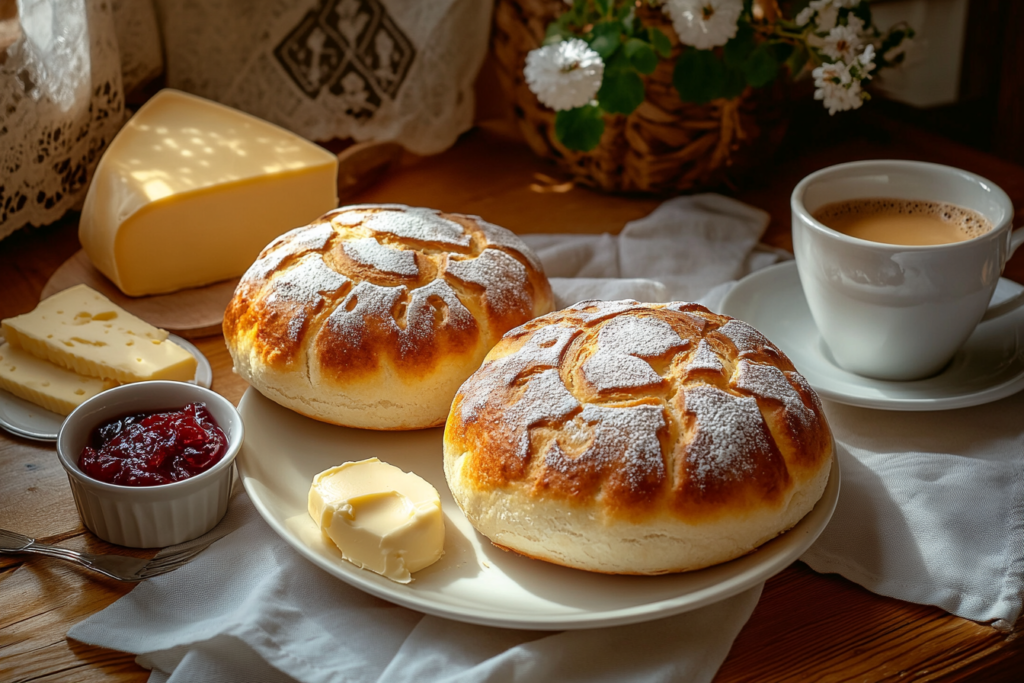1. Introduction
Croissants and Gipfeli may look alike, but what is the difference between a croissant and a Gipfeli? This article uncovers their unique origins, flavors, and textures, helping you understand what sets these two pastries apart.
If you’ve ever asked, “What is the difference between a croissant and a Gipfeli?”, this article will answer your question in depth. We’ll explore their histories, ingredients, preparation methods, and what makes each pastry unique to its respective culture—France and Switzerland.
By the end of this guide, you’ll gain a new appreciation for these buttery delights and know exactly what to look for when choosing between a croissant and a Gipfeli.
2. What is a Croissant? Understanding the French Classic
2.1 The Origin of the Croissant
The story of the croissant is as rich and layered as the pastry itself. Its origins can be traced back to Austria, where an early version called the Kipferl was enjoyed as far back as the 13th century. The Kipferl was a crescent-shaped bread, denser and less flaky than the croissant we know today.
The transformation from Kipferl to croissant occurred in the 19th century, thanks to French innovation. Austrian baker August Zang introduced the Kipferl to Paris when he opened his bakery, Boulangerie Viennoise, in 1839. French bakers quickly adopted the pastry and refined it by using laminated dough—a technique of layering butter and dough to create a light, flaky texture. Thus, the croissant was born and became a culinary symbol of France.
2.2 What Makes a Croissant Unique?
A croissant is instantly recognizable for its delicate, buttery layers and golden-brown crust. What sets it apart is the process of lamination, which involves folding butter into the dough multiple times. This creates distinct, airy layers that separate beautifully when baked.
Key features of a croissant include:
- Flaky Texture: Thanks to the careful layering of dough and butter.
- Rich Flavor: The generous use of high-quality butter gives croissants their unmistakable taste.
- Golden Appearance: A croissant is baked to perfection, resulting in a crisp, golden-brown exterior.
Ingredients for a classic croissant:
- All-purpose flour
- High-quality butter (preferably European-style for its high fat content)
- Water or milk
- Sugar
- Yeast
The French croissant is often enjoyed plain, but it can also come in variations such as pain au chocolat (chocolate croissant) or almond croissants.
2.3 Cultural Role of Croissants in France

In France, croissants are more than just pastries—they are a cultural staple. They are traditionally served as part of a light breakfast known as “petit déjeuner”. A typical French breakfast includes:
- A freshly baked croissant or pain au chocolat
- A cup of coffee (often café au lait or espresso)
- Fresh juice or fruit
Croissants are not heavily adorned with spreads; the focus remains on their natural buttery flavor. French cafés and boulangeries pride themselves on offering croissants made fresh daily, ensuring a flaky, melt-in-your-mouth experience.
Beyond breakfast, croissants are a symbol of French culinary excellence. They represent craftsmanship, precision, and a dedication to quality ingredients.
3. What is the Difference Between a Croissant and a Gipfeli? Exploring the Swiss Version
3.1 The Origin of Gipfeli: A Swiss Take on the Croissant
When discussing what is the difference between a croissant and a Gipfeli, it’s essential to understand the origins of the Swiss pastry. While the French croissant evolved from the Austrian Kipferl, the Gipfeli is Switzerland’s adaptation of this crescent-shaped delight.
The name Gipfeli comes from the German word “Gipfel”, meaning “peak” or “summit”—a reference to the pastry’s iconic curved shape. Introduced to Switzerland during the spread of Viennese-style pastries in Europe, the Gipfeli quickly became a popular staple in Swiss bakeries and homes.
Unlike French croissants, which highlight butter-rich lamination, Gipfeli prioritize simplicity and heartiness, aligning with Switzerland’s culinary traditions.
3.2 What is the Difference Between a Croissant and a Gipfeli in Appearance?
At first glance, croissants and Gipfeli may appear similar, but closer inspection reveals notable differences:
- Croissants:
- Croissants have a more pronounced crescent shape with slightly pointed ends.
- The layers of laminated dough create a visibly flaky and airy texture.
- Croissants often have a shiny, buttery finish.
- Gipfeli:
- Gipfeli tend to have straighter ends and a more compact crescent shape.
- The surface is typically matte, lacking the same buttery sheen of croissants.
- The layers are less distinct, resulting in a denser appearance.
These visual distinctions are subtle but highlight how what is the difference between a croissant and a Gipfeli extends beyond just taste. If you’re interested in trying your hand at making this Swiss specialty, check out this easy Gipfeli recipe for perfect Swiss pastries.
3.3 How Do Texture and Flavor Define the Difference Between a Croissant and a Gipfeli?
The texture and flavor of a croissant and a Gipfeli are where the most significant differences lie:
- Croissants:
- Known for their flaky, light layers created through precise lamination.
- The flavor is buttery and rich, thanks to a higher butter-to-dough ratio.
- Gipfeli:
- Swiss Gipfeli have a denser, chewier texture, making them heartier and more filling.
- The flavor is milder and less buttery, often incorporating milk in the dough for a subtle richness.
These differences cater to regional preferences: while the French favor decadence and flakiness, the Swiss appreciate Gipfeli for its practicality and versatility.
4. Key Differences Between a Croissant and a Gipfeli
When asking, “What is the difference between a croissant and a Gipfeli?”, it’s clear that the two pastries diverge significantly in several key areas. While both share a crescent shape and European roots, their preparation, texture, flavor, and cultural roles set them apart. Let’s break down these differences in detail.
4.1 What is the Difference Between a Croissant and a Gipfeli in Dough and Ingredients?
The ingredients and dough preparation play a crucial role in defining the differences between croissants and Gipfeli.
- Croissants:
- Croissants are made using laminated dough, a labor-intensive process of layering dough and butter multiple times.
- The recipe relies on high-quality butter, creating the rich, indulgent flavor and flaky texture.
- The dough uses flour, water, sugar, yeast, and salt, often with a small amount of milk for softness.
- Gipfeli:
- Gipfeli dough contains less butter than croissants, resulting in a denser and less flaky texture.
- Some recipes include milk, which softens the dough and adds a slight richness.
- The overall process is simpler, making Gipfeli more practical for large-scale baking.
The reduced butter content in Gipfeli is one of the key reasons for their milder flavor and compact layers, distinguishing them from the decadently buttery croissant.
4.2 How Texture and Appearance Show the Difference Between a Croissant and a Gipfeli
Texture and appearance are where croissants and Gipfeli reveal their unique characteristics:

- Croissants:
- Light, flaky layers that pull apart effortlessly.
- Crispy, golden-brown crust with a shiny finish due to the high butter content and an egg wash.
- The crescent shape is pronounced, with tapered ends forming delicate points.
- Gipfeli:
- Compact, denser texture that offers more chewiness than flakiness.
- A matte, golden surface with less sheen, as Gipfeli contain less butter and may not always have an egg wash.
- Straighter, less pronounced crescent shape, giving them a heartier appearance.
While croissants are celebrated for their delicate texture, Gipfeli offer a sturdier pastry that holds up better for quick breakfasts or snacks on the go.
4.3 Taste and Flavor: What Sets Croissants and Gipfeli Apart?
When comparing what is the difference between a croissant and a Gipfeli, flavor plays a significant role:
- Croissants:
- The flavor is buttery, rich, and slightly sweet, offering a melt-in-your-mouth experience.
- High-quality butter enhances the flavor, making the croissant indulgent even when served plain.
- Gipfeli:
- The flavor is milder and less buttery, making Gipfeli more versatile for savory or sweet pairings.
- The inclusion of milk in some recipes adds a subtle richness without overwhelming the palate.
The croissant’s buttery taste makes it a quintessential French delicacy, while Gipfeli’s balanced flavor caters to Switzerland’s love for simplicity and practicality. Understanding subtle differences in baked goods—like the difference between crème brûlée and custard—helps appreciate how ingredients and methods shape the final product.
4.4 Cultural Roles: How Croissants and Gipfeli Fit Into Daily Life
Cultural traditions further highlight what is the difference between a croissant and a Gipfeli:
- Croissants in France:
- Croissants are central to the French breakfast culture, known as “petit déjeuner”.
- They are typically enjoyed fresh from the bakery alongside coffee, with minimal additions to let the pastry’s flavor shine.
- Croissants are a symbol of French culinary craftsmanship and elegance.
- Gipfeli in Switzerland:
- Gipfeli are an everyday staple in Swiss breakfasts and café culture.
- They are often served with butter, jam, or Swiss cheese for a balanced and filling meal.
- Unlike croissants, Gipfeli are more practical for on-the-go eating, making them popular among busy professionals and families.
While croissants evoke indulgence and artistry, Gipfeli reflect Swiss pragmatism, offering a satisfying and accessible treat.
5. How Are Croissants and Gipfeli Made?
Understanding what is the difference between a croissant and a Gipfeli involves looking at how these two pastries are made. While they share similar roots, their preparation processes differ in key ways, impacting their final texture, appearance, and taste.
5.1 The Art of Making a Croissant
Making a croissant is a labor of love, requiring precision, patience, and the right technique.
- Ingredients:
- All-purpose flour
- High-quality butter (for lamination)
- Yeast
- Water or milk
- Sugar
- Salt
- The Lamination Process:
- Step 1: Prepare a basic yeasted dough and let it proof until it rises.
- Step 2: Roll out the dough into a rectangle and place a cold block of butter in the center. Fold the dough over the butter to encase it fully.
- Step 3: Roll and fold the dough multiple times (usually 3 to 4 times), chilling it between folds to maintain the butter layers. This process is called lamination, which creates the flaky texture of a croissant.
- Step 4: After the final fold, the dough is rolled thin and cut into triangles. Each triangle is rolled from the base to the tip to form the iconic crescent shape.
- Step 5: Proof the shaped croissants until they puff up, then brush them with an egg wash. Bake at 375°F (190°C) until golden-brown and crispy.
The Result:
Croissants have thin, buttery layers that separate beautifully when baked. The flaky texture and crisp crust make them light and airy while maintaining a rich, indulgent flavor. For more insight into how the Swiss name and adapt this iconic pastry, explore our guide on what croissant is called in Switzerland.
5.2 The Process of Making a Gipfeli

The process of making a Swiss Gipfeli is simpler and less time-consuming than a croissant. The dough and lamination are less intensive, which contributes to its denser texture.
- Ingredients:
- Flour
- Less butter than croissants
- Milk (optional for a softer dough)
- Yeast
- Sugar
- Salt
- Steps to Make Gipfeli:
- Step 1: Prepare a yeasted dough, similar to bread dough, and allow it to rise.
- Step 2: Roll out the dough and fold it a few times. Unlike croissants, Gipfeli do not go through an extensive lamination process.
- Step 3: Roll the dough into a rectangle and cut it into triangles. Roll each triangle into a crescent shape, similar to croissants.
- Step 4: Brush the Gipfeli with egg wash or milk for a golden finish. Bake at 350°F (175°C) until lightly golden and cooked through.
The Result:
Gipfeli have a denser, chewier texture compared to croissants. The surface is matte rather than flaky, and the flavor is milder with less buttery richness.
5.3 Side-by-Side Comparison of Recipes
Here’s a quick overview of the main differences between croissants and Gipfeli in terms of preparation:
| Aspect | Croissant | Gipfeli |
|---|---|---|
| Butter Content | High (for flaky layers) | Low to moderate |
| Dough Process | Extensive lamination | Basic folding with minimal layers |
| Texture | Flaky, airy, and light | Dense, soft, and chewy |
| Shape | Crescent with tapered ends | Straighter crescent shape |
| Flavor | Rich, buttery, and indulgent | Mild, less buttery |
This simplified preparation makes Gipfeli more accessible to bakers while croissants remain a labor-intensive delicacy requiring skill and precision.
6. FAQs About Croissants and Gipfeli
6.1 What is the Difference Between a Croissant and a Gipfeli?
The primary differences are in texture, flavor, and butter content. Croissants are flaky, buttery, and light due to extensive lamination, while Gipfeli are denser, chewier, and less rich, with a matte surface.
6.2 Why is Swiss Gipfeli Less Buttery Than Croissants?
Gipfeli use less butter in the dough compared to French croissants. This results in a milder flavor and denser texture, reflecting the Swiss preference for simpler, heartier baked goods.
6.3 Which Pastry is Healthier: Croissant or Gipfeli?
Gipfeli are generally lower in butter and fat compared to croissants, making them a slightly lighter option. However, both pastries are indulgent treats best enjoyed in moderation.
6.4 Can You Find Gipfeli Outside of Switzerland?
While Gipfeli are primarily unique to Switzerland, some European bakeries or Swiss cafés abroad may offer them. However, they are less commonly available compared to croissants.
6.5 Are Croissants and Gipfeli Made the Same Way?
No, croissants require extensive lamination to create their flaky layers, while Gipfeli involve simpler dough preparation with fewer folds, resulting in a denser pastry.
7. Conclusion
The question “What is the difference between a croissant and a Gipfeli?” reveals far more than a simple comparison. While both pastries share a similar crescent shape and historical roots, they offer unique textures, flavors, and cultural significance.
- Croissants are rich, buttery, and celebrated as a delicate French culinary masterpiece.
- Gipfeli, on the other hand, represent Swiss practicality—offering a denser, milder alternative perfect for everyday enjoyment.
Whether you savor a flaky croissant in Paris or enjoy a hearty Gipfeli in Zurich, both pastries bring joy to breakfast tables worldwide. Their differences only add to their charm, giving food lovers a reason to appreciate each one for its unique qualities.
The next time you visit a bakery in Switzerland or France, you’ll know exactly what sets a croissant apart from a Gipfeli, and perhaps you’ll try both to decide your favorite!
